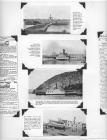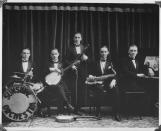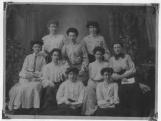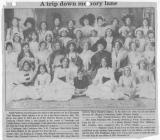14
The Ottawa River itself was the focal point for much of the area's social scene. People of different standing often mingled on the steamships that plied the Upper Ottawa River. With the coming of the railroad to Pembroke in 1876, this social milieu slowly faded from its position of importance; but never entirely.16
"In the beginning, it was only the wealthy that could afford the city house and the country house… Some of the lumbering money of [C.L] McCool established the romantically rambling white frame three-winged summer inn called the Pontiac Hotel, built at Fort William on the site of the former Hudson Bay Post. The first guest ledger of the Pontiac Hotel dated summertime 1910 lists clientele from all over the world…. Most of the guests, however, were Old Pembroke Money, the upstart nouveau riche and the military from Petawawa and Ottawa."From "Laughing All the Way Home", by Joan Finnigan, 1984:
17
Accounts of the time often refer to the fashion and splendour of life around the steamships. The ships were also sometimes the scene for political maneuvering that often contributed to Pembroke's prominence and economic success, as can be seen from the last paragraph here."In the decade immediately after Confederation, Pembroke was the home port of the fleet of the Union Line. These steamers - such as the "Forest Queen" and the "C. O'Kelly" - were palatial craft equipped with mahogany cabins and bars.
The Pembroke shipyard was noted for its craftsmanship in turning out the pride of the river fleet. The christening of these river steamers was a social event.
When the "Forest Queen" left the ways at the Pembroke shipyard on May 6, 1872, according to a news writer of that day there was present "a large proportion of the beauty and fashion of the Town."
When Mrs. O'Kelly, wife of the vice-president of the Line, cracked a champagne bottle over the bows of the "Forest Queen", she and the ship were applauded by the socially elite of the Townspeople which included: the Whites, Dunlops, Supples, Irvings, Moffatts, Loucks, Murrays, Copelands, Dicksons, and Morris'.
… But those old days of mid-Victorian glory and splendor on our river have gone. No longer the plume of black smoke and the echoing bellow of the steamers' whistle proclaims steamboat round the bend. No longer are the big boats met at the quay by silkhatted "quality" and redshirted rivermen.
… According to legend, the old Pontiac, the first paddle wheeler on the Upper Ottawa, was the setting for an important manoeuvre by John Supple to make Pembroke the County Capital. The story tells that he commissioned the Pontiac to entertain the Governor General on an Upper Ottawa cruise to impress him with Pembroke's strategic importance. Support on the future of Pembroke was thought to be assured."
From the Pembroke Women's Institute Tweedsmuir History.
19
Oiseau Rock is a striking geographic feature on the Quebec side of the Ottawa River above Petawawa. It was one of the main attractions on the steamship routes on the Upper Ottawa."Old Pembroke Money had already taken over the beautiful storied islands of the Ottawa that lie in this stretch of the river around fort William. In 1904 American writer Anson Gard described the steamer trip from Pembroke to "Weezah Rock" with Captain Will Murphy on the Victoria.
…All along the way the captain name-drops; 'That pretty island you see to the right belongs to our Member of Parliament, Hon. Thomas Mackie. There to the left is the Petawawa River and that beautiful grove on the point belongs to one of our lawyers, J.H. Metcalfe. That is George Gordon's Island and that is Edward Dunlop's Island. That's Darcey's Island, used as a camp by the Darcey's Club of Ottawa. And that naphtha launch we just passed belongs to Charlie McCool, Member for Nipissing…. That fine island over there belongs to W.R. White, president of this steamboat company…. And Captain Murphy continued pointing out the islands… owned by the wealthy, influential and powerful of that time in the Valley: Thomas Pink, C. Chapman, Robert Delahaye, John McCormick, Kenning and Sutton, A. Archer, James A Thibodeau and C.L.McCool."
From "Laughing All the Way Home", by Joan Finnigan, 1984
21
Here is just one example of the kind of event to which some of the fashions in our shows would have been worn. A "benedict" is a confirmed bachelor who has recently married."Benedicts' and Batchelors' Ball. One of the Most Brilliant Social functions of the Season. Large Attendance From both in and Out of Town.
The Benedicts'and Bachelors' Ball given at the Copeland House Monday night proved to be one of the most brilliant social events of the social season as far as Pembroke is concerned. It was an unqualified success in every respect. Pembroke's fashionable set was splendidly represented, and there were many present from out of town. In all about 120 ladies and Gentlemen accepted invitations and the display of beautiful costumes by the ladies in attendance was a noteworthy one.
The patronesses were: Mrs. D.J. Donahue, Mrs. J.L. Supple, Mrs. W.F. Munro, Mrs. G.V. White, Mrs. H.J. Mackie, Mrs. J.C.L. White.
Valentine's orchestra had been brought up from Ottawa for the occasion and excellent music was furnished. There were twenty-six dances on the programme, and the floor of the handsome ball-room was well-filled from the grand march, with which the ball was opened at 9:30 sharp, until half-past four a.m.
…the element of universal good feeling and mutual understanding which speedily brushed aside stiff and unnecessary formalities was one of the striking and especially pleasing features of this noteworthy gathering of the beauty and fashion of Pembroke's best social circles.
… The unusual interest aroused by this fashionable and representative gathering was aptly illustrated by the big crowd gathered in Victoria Street upon which the windows of the ball room opened. There were dense crowds besieging the windows long before nine o'clock and there were not a few of these spectators still in evidence as late as 2.30 a.m. yesterday morning.
All in all, this is believed to have been the most successful at home and ball ever given by the benedicts and bachelors of Pembroke."
From The Pembroke Standard, April 27,1910
22
The Upper Ottawa Valley was, at the time of these fashions, a place where parties happen on almost every and any occasion. This would have been an important factor in the formation and maintenance of the social scene of which these fashions were such a large part. The Valley maintains its very social and welcoming aspect to this day.The following is from "For Singing and Dancing and all Sorts of Fun, The Story of the Ottawa Valley's Most Famous Song, The Chapeau Boys," by I. Sheldon Posen, Deneau, 1988
"It [The Chapeau Boys] turns up at many major musical events and most minor ones in the community: birthday parties, wedding parties, Christmas parties, card parties, welcome parties for strangers, farewell parties for anyone, parties to celebrate the opening of a welding business, mixed stags, male stags, box socials, square dances, street dances, Winter Fair dances, barn dances, parish dances, kitchen stags, Friday evening sings in the back room at the hotel, St. Patrick's Day sings in the front room of the hotel, high school concerts, concerts for the Golden Age Club, amateur night concerts, concerts to raise money to buy uniforms for the Chapeau junior league baseball team, outings by bus, car rides, truck rides, and the odd tractor ride."
24
While the young women in this photograph are dressed in what might be considered at the time as casual fashion, the quotation below sets out some of the standards of the era."In the Champlain Trail Museum, store window dummies display the women's styles of the early 1900s. A long white fitted wedding dress in embroidered lace with high neckline and long sleeves was worn in 1909.
The slippers were soft white satin embroidered with pearls.
A plum-coloured full length flowing gown with tiered skirt and long sleeves, and a plum feathered hat with wide brim was an outfit worn by a bride in 1882.
A tailored dress, beautifully stitched, partly by hand and partly on a hand-turned sewing machine, indicated a lot of hard work. The dress, 102 years old, came from a lady in Alice Township. The tweed full-length dress was fitted with "leg of mutton" sleeves and the button holes were perfectly stitched.
It is interesting to note, when you look at women's clothing from [the 19th century], that a tiny waist and tiny feet distinguished them from the more robust figures of today's women.
The famous hoop 'n' bustle gave women a prima donna look. Rows of circular wiring and protruding hoops in the rear spread any skirt a yard out from the waist.
For men and women alike, fashion dictated a high stiff neckline, long sleeves and covered anatomy."
From The Pembroke Women's Institute Tweedsmuir History
26
Another look at Pembroke's social milieu, this one in 1912, and the types of fashions that were worn. One question remains, however: are these women in Dickensian fashions, given the event, the Dickens Bazaar, or are they in fashions of their own time?Photograph from the Pembroke Observer.





